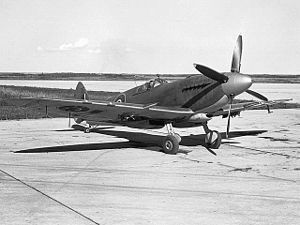| Seafire | |
|---|---|
 Royal Canadian Navy Seafire F.XV | |
| General information | |
| Type | Carrier-based fighter |
| National origin | United Kingdom |
| Manufacturer | Supermarine |
| Status | Retired |
| Primary users | Royal Navy |
| Number built | 2,646[1] |
| History | |
| Introduction date | 1942 |
| First flight | 7 January 1942 |
| Developed from | Supermarine Spitfire |
The Supermarine Seafire is a naval version of the Supermarine Spitfire fighter adapted for operation from aircraft carriers. It was analogous in concept to the Hawker Sea Hurricane, a navalised version of the Spitfire's stablemate, the Hawker Hurricane. The name Seafire was derived from the contraction of the full name of Sea Spitfire.[2]
A carrier-capable version of the Supermarine Spitfire had been proposed by the Admiralty in May 1938. Despite a pressing need to replace various obsolete types in the Fleet Air Arm (FAA), some opposed the idea, including as Winston Churchill, although these disputes were often a result of the overriding priority for land-based Spitfires instead. During 1941 and early 1942, the Admiralty again requested naval Spitfires, resulting in an initial batch of Seafire Mk.Ib fighters in late 1941, which were mainly used to gain experience operating the type. There were concerns over weak undercarriages, which had not been strengthened to naval standards, but performance was acceptable.
From 1942 on, further Seafire models were ordered, including the first operationally-viable Seafire F Mk.III variant. This led to widespread use with the FAA. In November 1942, the first Seafire combat occurred during Operation Torch, the Allied landings in North Africa. In July 1943, the Seafire provided air cover for the Allied invasion of Sicily, and again in September 1943 during the Allied invasion of Italy. During 1944, large numbers provided air support to ground forces during the Normandy landings and Operation Dragoon in southern France. During the latter half of 1944, Seafire joined the British Pacific Fleet, where it intercepted kamikaze attacks which had become common during the final years of the Pacific War.
The Seafire continued to be used after the end of the war, but the FAA withdraw all its Merlin-powered Seafires and replaced them with Griffon-powered counterparts. The type saw further combat use during the Korean War, in which FAA Seafires performed hundreds of missions in the ground attack and combat air patrol roles against North Korean forces in 1950. The Seafire was withdrawn from service during the 1950s. In FAA service, the type had been replaced by the Hawker Sea Fury, the last piston engine fighter to be used by the service, along with the first generation of jet-propelled naval fighters, such as the de Havilland Sea Vampire, Supermarine Attacker, and Hawker Sea Hawk.